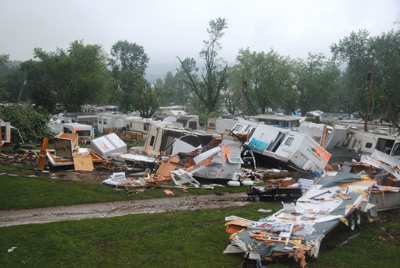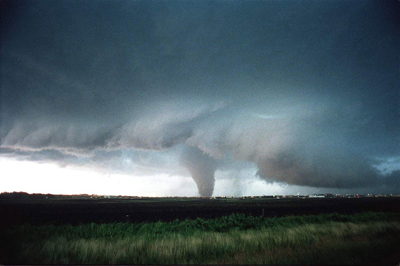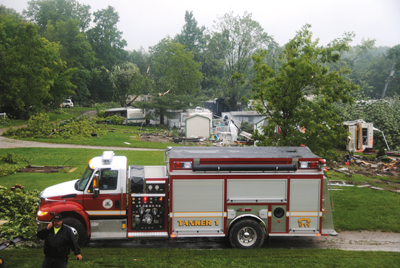
Features
Hot topics
Research
Disaster response
When a tornado tore through a trailer park in northeast Edmonton on July 31, 1987, the first responders were not Edmonton firefighters or Edmonton police or ambulance or even volunteer firefighters from the neighbouring forensic psychiatric hospital.
November 22, 2012
By Joseph Scanlon and Jelle Groenendaal
When a tornado tore through a trailer park in northeast Edmonton on July 31, 1987, the first responders were not Edmonton firefighters or Edmonton police or ambulance or even volunteer firefighters from the neighbouring forensic psychiatric hospital.
 |
|
| Ordinary people are generally the first to respond to any natural disaster, such as the F2 tornado that struck Midland, Ont., in June 2010. The Amsterdam-Amstelland Fire Department has developed policies to include citizens in the response to large-scale incidents that help responders decide whether and how to co-operate with people, organizations and groups. Photo courtesy Midland Fire Department
|
The first responders were uninjured and injured survivors. They did the initial search and rescue and they used their own vehicles to transport injured people to medical centres.
By the time volunteer firefighters arrived, those Good Samaritans and the people they had rescued had left: no one remained to tell responders who was still buried in the wreckage.
There was another complication: the tornado struck at the start of evening rush hour. As firefighters and then police tried to sort out what needed to be done, they were besieged by arriving residents who were convinced, usually wrongly, that their relatives still needed rescuing. It soon became apparent that no one knew the precise situation; so police and the volunteer firefighters teamed up to do a systematic search of the wreckage. One at a time, they located trapped and severely injured victims, people the survivors had been unable to rescue.
Most emergency plans assume that an emergency will be at a specific site or location and that the entire response will be by emergency agencies working together. Ordinary people will not be involved.
 |
|
| Although the fact that ordinary people get involved in emergency response has been well documented, many emergency planners and emergency agencies resist this: some plans state explicitly that civilians should not be allowed to take part in the response. Photo credit: The Canadian Press Images/Edmonton Journal/Steve Simon |
In fact, in a widespread destructive incident, this is not what happens. In Edmonton, for example, the tornado was on the ground for 65 minutes and it left behind a trail of destruction, injury and death that started south of the city, continued as the tornado headed north, passed briefly through part of Strathcona County, and reached the Evergreen Mobile Home Park. Long before then, Edmonton’s emergency agencies – fire, police and ambulance – were committed to other parts of the city. In addition, roads were blocked by debris and flooding. By then, too, emergency communication systems were overloaded. In short, individuals at the trailer park did the initial search and rescue because there was no else around to do it and because immediate assistance was required.
Events such as the Edmonton tornado – 26 dead, about 400 injured – are rare; but a response by ordinary people is not. The fact is that when there is a disaster – no matter what the cause of the incident or its size – ordinary people are not confused or in shock or in panic, and they don’t stand around and wait for someone to help: they look around and do whatever they can.
When Swissair crashed into the Atlantic Ocean off Peggy’s Cove, N.S., in 1998, the first response was by local fishermen. When the first Royal Canadian Navy ship arrived, it welcomed the fishermen’s response and helped them form organized lanes for searching. Similarly, after the terrorist attack on New York City in 2001, hundreds of small craft helped citizens evacuate from Lower Manhattan. Even before that, it was ordinary people who decided to evacuate the twin towers while voice messages were telling them everything was all right.
Although the fact that ordinary people get involved in emergency response has been well documented, many emergency planners and emergency agencies resist this: some plans state explicitly that civilians should not be allowed to take part in the response.
 |
|
| The Amsterdam-Astelland Fire Department’s new protocol says that all emergency responders are allowed to accept help from ordinary citizens in the case of disasters such as tornados. Photo courtesy Midland Fire Department
|
The Amsterdam-Amstelland Fire Department, the largest fire department in the Netherlands, is taking a different approach. It is trying to figure out how to involve ordinary people in its response planning. It even staged an incident in front of a threatre just as patrons were coming out so it could see what they did. The department started in 2004 staging workshops in which firefighters, police, local officials and disaster researchers discussed the role of ordinary citizens in emergencies. These workshops made it clear that ordinary citizens can become involved in different ways: they can act on their own as individuals or groups, just as the people did in Edmonton; or they can take on tasks assigned to them by emergency personnel.
In the wake of the Mexico City earthquake – where there were thousands of volunteer rescuers – the Los Angeles Fire Department decided it would be appropriate not just to accept that ordinary citizens might get involved in emergency response but to recruit and train citizens to perform or assist with a number of emergency tasks. The approach is known as Citizen Emergency Response Training (CERT). The 18-hour training course has been adopted by other U.S. communities and by some other countries, and includes light search and rescue, fire suppression, first aid, transportation of the injured, communication and leadership skills.
CERT is similar in many ways to the Canadian civil defence training for volunteers that took place during the peak of the cold war, but it is quite different from what the Dutch have in mind. They want to determine what untrained civilians do in emergencies so that these actions can be taken into account when firefighters and other emergency personnel respond.
Let’s assume that what happened in Edmonton happens again, and that ordinary people take injured civilians, stick them into their vehicles and drive them to the nearest hospital. What happens when these people arrive at hospital? Hospital personnel are not used to extracting victims from vehicles. Firefighters are used to doing that. That means it would make sense – given a widespread destructive incident – to have some firefighters respond to hospital emergency rooms to help safely handle the injured who arrive in private vehicles. That may sound absurd, but it is this kind of unorthodox approach that is being discussed in Amsterdam.
There are occasions when ordinary citizens can make a valuable contribution to the response by professionals because they do things that firefighters initially are unable to do: they provide assistance to less injured people, shelter people, evacuate and warn fellow citizens. And they often also assist professional responders: ordinary citizens may have better local knowledge, resources and expertise than the first-arriving units of emergency services.
The point of the Amsterdam initiative is not to tell others how to plan, but to change the mindset of emergency personnel so that they better understand how to work with ordinary people at an emergency scene, rather than moving them out of the way. The goal is to have responders recognize what people will do before emergency personnel arrive, have a plan for enlisting their support, and make sure what they do enhances the response.
The Dutch project is still very much a work in progress and there are still serious issues to be resolved.
First, emergency responders are often unwilling to accept assistance from ordinary people due to the possibility of being held accountable if volunteers get injured. That, of course, is not an issue if the response occurs before emergency personnel arrive but it is an issue after that.
Second, professional responders find it difficult to assess whether ordinary citizens are able to make a valuable contribution. For instance, professional responders worried about how they could identify someone as a physician. In Amsterdam-Amstelland, procedures require that professional responders ask ordinary citizens to show evidence that they have specialized skills and knowledge.
Third, it is now often a requirement that volunteers be screened if they are likely to be dealing with children to make sure that they have no record of sexual offences. This suggests that if emergency planners wish to integrate ordinary people into emergency response they need to consider how they will take whatever steps are required to make them acceptable.
To help professional responders make better use of ordinary citizens, the Amsterdam-Amstelland Fire Department has developed new procedures. The core of the new policies is a set of criteria that helps emergency responders decide whether and how to co-operate with ordinary citizens, organizations and emergency groups.
First and most important, the new policies specify explicitly that all emergency responders are allowed to accept assistance from ordinary citizens and organizations in the emergency work. Co-operating with citizens and allowing citizen’s response is therefore a (new) professional standard.
That does not mean co-operation with ordinary people is always desired; there are some conditions that must be met:
- Co-operation must be voluntary – no individual group or organization can be forced to participate in the emergency work.
- The tasks assigned should be without many safety risks.
- The tasks should add value to the overall emergency response.
- Ordinary citizens can only be asked to fulfil a task when they have the skills and knowledge to complete the task successfully.
To facilitate the use of these criteria in practice, the Amsterdam-Amstelland Fire Department developed a five-phase model.
- Phase one assumes that victims and bystanders will start by providing help and mitigate the crisis situation before emergency personnel arrive.
- In phase two, the first few professional responders will arrive. In this phase, professional responders are taught to accept assistance and not to push ordinary people aside.
- Phase three starts when commanders in charge of the fire brigade, police and medical service arrive: when they are on hand citizen response will be discussed in the first structured meeting, and a decision should be made about its effectiveness. If appropriate, arrangements will be made for registration of volunteers.
- Phase four occurs when the operation continues under control by the professional emergency agencies. In this phase, no new helping citizens will be allowed unless the incident commander requests it.
- Phase five requires that officials thank citizens who made a contribution to the emergency response – and that officials explore the possibility of compensation for possible damage to personal belongings.
In short, private citizen involvement must be considered at all stages of emergency response.
The Amsterdam Fire Department believes it has a responsibility to provide leadership to others with fewer resources. However, it acknowledges that in large-scale emergencies, it has too little capacity to help all those who need may help, especially in the first few hours; and – most important – there is a growing awareness within the department that the help of ordinary citizens is important for the effectiveness of the response by professionals. Ordinary citizens often make it better.
Joseph Scanlon is professor emeritus and director of the Emergency Communications Research Unit (ECRU) at Carleton University in Ottawa; he has been studying emergency response for 42 years. Jelle Groenendaal is a doctoral student who is working with the Amsterdam-Amstelland Fire Department.
Print this page